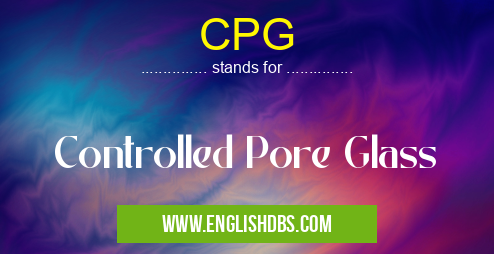What does CPG mean in UNCLASSIFIED
Controlled Pore Glass (CPG) is a type of silica-based solid material that can be used for both chemical and biochemical applications in analytical laboratories. It has a wide range of uses due its unusual combination of properties, the most notable being its ability to hold an enormous amount of space within its pores. CPG is especially valued for its high porosity, large pore size range, good mechanical strength and excellent thermal stability. All these characteristics make it an ideal choice for adsorption processes such as chromatography and solid-phase extraction.

CPG meaning in Unclassified in Miscellaneous
CPG mostly used in an acronym Unclassified in Category Miscellaneous that means Controlled Pore Glass
Shorthand: CPG,
Full Form: Controlled Pore Glass
For more information of "Controlled Pore Glass", see the section below.
What CPG Means?
CPG stands for Controlled Pore Glass, a type of porous silica matrices with a relatively uniform structure that enables good control over particle size. These matrices are composed mainly of amorphous silica particles and have pore sizes ranging from around 100 nm to approximately 2 µm in diameter. The pores on the surface of the CPG matrix act as binding sites for compounds which can later be extracted or isolated via various methods, such as chromatography or solid-phase extraction.
Applications of CPG
CPG materials have been used extensively in several fields of research including analytical chemistry, biochemistry, materials science, environmental studies, pharmaceuticals and biomedical sciences. Some applications include but are not limited to: sample preparation for gas chromatography; selective adsorption; separation and purification; protein crystallization; DNA sequencing; peptide synthesis; cell lysis; biomolecular analysis etc. Furthermore, these materials are also used in microfluidics devices where they provide confinement and controlled flow paths for fluids within an integrated system. Additionally, CPGs are suitable substrates for biochip fabrication due to their high levels of manufacturability and low production costs.
Essential Questions and Answers on Controlled Pore Glass in "MISCELLANEOUS»UNFILED"
What is Controlled Pore Glass (CPG)?
Controlled pore glass (CPG) is a type of porous glass bead that has a consistent and uniform porosity in its walls. It is used to capture, isolate, and analyze biological molecules for industrial research and development.
What are the properties of CPG?
CPG has several unique characteristics such as high chemical resistance, small pore size and good mechanical stability. It is also inert, transparent, and hydrophobic, which makes it excellent for use in chromatography applications.
How can CPG be used in research?
CPG can be used for a range of biological research applications such as sample preparation, reaction optimization studies, analytical separations, protein purification and more. It provides an efficient way to separate proteins from complex mixtures or reduce contaminants or impurities from samples.
Why should I use CPG instead of other substrates?
The consistent pore structure of CPG provides better column performance than other substrates such as silica or ceramic materials. It also offers superior performance for chromatography separations compared to non-porous materials due to its large surface area and uniform porosity throughout its structure.
What advantages does CPG have over other separation media?
Compared to other separation media like liquid chromatography (LC) columns, CPG offers improved analyte recovery due to its tight pore size distribution which allows for efficient trapping and release of biomolecules. Additionally, due to its inertness it can be used in a wide range of pHs without any adverse effects on the sample molecules or columns performance making it ideal for low pH applications.
Does using CPG impact yield during protein purifications?
Yes! Using CPG during protein purifications helps improve yields by providing optimal conditions for sample purity while minimizing losses due to adsorption losses on the substrate material itself which can occur with other types of substrates. Additionally, using high quality synthetic glass beads helps minimize cross-contamination even when reusing the same batch multiple times offering greater value when working with limited resources.
Can I use recycled or reused batches with CPG?
Absolutely! Unlike most standard silicate based substrates which must be discarded after each use due to contamination concerns associated with silicates leaching into solution, high quality controlled pore glass beads show very low leaching levels meaning they can be reused up 5 times before needing replacement.
Does CPG have any limitations?
Although it is suitable for many biotechnological uses, one limitation might be that some ions are known to interact with the surface of the substrate resulting in reduced resolution power if using ionic species such as salts during separations.
Final Words:
In conclusion, Controlled Pore Glass (CPG) is a highly versatile material that can be used across several different scientific disciplines due to its unique properties such as high porosity, large pore size range and excellent thermal stability. Its main application lies in adsorption processes like chromatography or solid - phase extraction where it shows great potential due to its uniform structure which enables good control over particle size and surface area available for interfacing between compounds or molecules held inside its pores.
CPG also stands for: |
|
| All stands for CPG |
